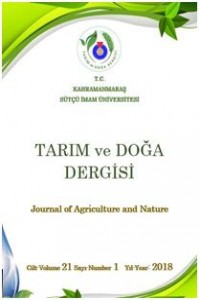Güneydoğu Anadolu Bölgesinde Yetişen Yeşil Acı Biberlerdeki Kapsaisinin DNA Koruyuculuğu Üzerine Etkisi
Öz
Güneydoğu
Anadolu bölgesinde yaygın olarak yetiştirilen Capsicum annuum L. türü yeşil
biber özellikle hem üretilmekte hem de yoğun bir şekilde tüketilmektedir. Bu
bitkinin doğal içeriği olan kapsaisin biberlerdeki en önemli sekonder
metobilitlerden biri olup antikarsionejenik ve antimutajenik potansiyele sahip
olduğu bilinmektedir.
Bu çalışmada Gaziantep bölgesinde tüketilmekte olan acı yeşil biberlerden
saflaştırdığımız kapsainin antiradikalik, antioksidan durumları ve DNA koruyucu
aktivitesi üzerine etkileri incelenmiştir. Bu amaçla, toplanıp, gölgede
kurutulup öğütülen yeşil acı biber
numunelerinden methanol ve
diklormetan içerisinde 72 saat’lik bir yöntem ile saf kapsaisin ekstraktı elde
edilmiştir. Saflaştırılan kapsaisinden antioksidan aktivitesi tespiti için Rel Assay Diagnostics
kitleri (TAS, TOS) ve antiradikalik aktivite tespiti için de DPPH yöntemi
kullanılmıştır. DNA koruyucu aktivite için pBR322 plazmid DNA’sı ve UV-C
yöntemi kullanılmıştır. Kapsaisinin diklormetandaki ekstrakti hem antioksidan
hem de antiradikalik aktivite yönünden metanole göre daha iyi bulundu.
Kapsaisinin oksidan değerlerinin ise standartlara göre oldukça düşük olduğu
gözlenmiştir. DNA koruyucu aktivite yönünden sonuçlar incelendiğinde
kapsaisinin diklormetan ekstrakı düşük konsantrasyonlarda daha yüksek koruyucu
ekti gösterirken metanoldeki ekstraktı yüksek konstrasyonlarda daha iyi koruyucu
etki göstermiştir. Sonuç olarak bu çalışma ile yeşil biberlerdeki kapsaisinin
antioksidan, antiradikalik ve DNA koruyucu aktivitesinin olduğu ortaya
konulmuştur.
Anahtar Kelimeler
Kaynakça
- Thomas, BV., Schreiber, AA, Weiskopf, PC 1998. Single methof for quantitation of Capsainoids in peppers using capillary gaz chromatography. J Agri Food Chem. 46 : 2655-2663.
- Bisset, DL., Chatterjee, R., Hannon, DP 1990. Photoprotective effect of msuperoxide-scavenging anti-oxidants against ultraviolet mradiation-induced skin damage in the hairless mouse. Photodermatol Photoimmunol Photomed.7:56-62.
- Krinsky, N. I 1994. The biological properties of carotenoids. Pure Appl.
- Chem. 66 : 1003-1010
- Prasad , N.S., Raghavendra, R., Lokesh B.R., Naidu K.A 2004. Spice phenolic inhibit human PMNL 5-lipoxygenase. Prostagl. Leukotr. Essent. Fatty Acids, 70; 521-528.
- Salimath, B.P. Sundaresh C.S, Srivinas L. 1986. Dietary components inhibit lipid peroxidation in erythrocyte membrane. Nutr.res. 6:1171-1178.
- Surh, YJ., Lee, SS 1996. Capsaicin in hot chili pepper: Carcinogen, co-carcinogen or anticarcinogen?. Food Chem Toxicol. 34: 313–316.
- Surh, YJ 2002. Anti-tumor promoting potential of selected spice ingredients with antioxidative and anti-inflammatory activities: A short review. Food Chem Toxicol. 40: 1091–1097.
- Segi, H., Yamada, S., Kato, S., Murasigo, S. Method of industrial purification of capsaicin . Patent number : 5,955, 631. September 21, 1999.
- Srinivasan, K 2016. Biological Activities of Red Pepper (Capsicum annuum) and Its Pungent Principle Capsaicin: A Review.Crit Rev Food Sci Nutr. 3;56(9):1488-500
- Russo, A, Acquaviva R, Campisi A, Sorrenti, V, DiGiacomo, C, Virgata, G, Barcellona, ML, Vanella, A. (2000). Bioflavonoids as antiradicals, antioxidantsand DNA cleavage protectors. Cell. Biol. Toxicol., 16: sayfa 91-98.
- Şener, E., Şahin, S 2010. Kapsaisin: Farmakokinetik, Toksikolojik ve Farmakolojik Özellikleri Hacettepe Üniversitesi Eczacılık Fakültesi Dergisi. 29(2) : 149-163.
- Baskin, S.I., Salem, H. 1997. Oxidants, antioxidants and free radicals. Washington, (DC) , Taylor & Francis Publishers, p- 23-77.
- Bayil, Oguzkan S., Uğraş, S., Aksoy, E.S., Ülger, S., Üzmez, Ş., Karagül, B., Uğraş, Hİ 2016. Biological Activity Analysis of Hazelnut Nutshell Extracts. International Journal of Chemical and Natural Science. 4 (5) : 481-485.
- Baskin, S.I., Salem, H. 1997. Oxidants, antioxidants and free radicals. Washington, (DC) , Taylor & Francis Publishers, p- 23-77.
- Bisset, DL., Chatterjee, R., Hannon, DP 1990. Photoprotective effect of msuperoxide-scavenging anti-oxidants against ultraviolet mradiation-induced skin damage in the hairless mouse. Photodermatol Photoimmunol Photomed.7:56-62.
- Bayil, Oguzkan S., Uğraş, S., Aksoy, E.S., Ülger, S., Üzmez, Ş., Karagül, B., Uğraş, Hİ 2016. Biological Activity Analysis of Hazelnut Nutshell Extracts. International Journal of Chemical and Natural Science. 4 (5) : 481-485.
- Baytop, T 1999. Therapy with Medicinal Plants in Turkey (Past and Present), 2nd ed. Nobel Tıp Kitabevi, Istanbul, Turkey.
- Russo, A, Acquaviva R, Campisi A, Sorrenti, V, DiGiacomo, C, Virgata, G, Barcellona, ML, Vanella, A. (2000). Bioflavonoids as antiradicals, antioxidantsand DNA cleavage protectors. Cell. Biol. Toxicol., 16: sayfa 91-98.
- Şener, E., Şahin, S 2010. Kapsaisin: Farmakokinetik, Toksikolojik ve Farmakolojik Özellikleri Hacettepe Üniversitesi Eczacılık Fakültesi Dergisi. 29(2) : 149-163.
- Tarpey, M.M., Wink, D.A., Grisham, M.B 2004. Methods for detection of reactive
- Tepe, B., Degerli, S., Arslan, S., Malatyali, E., Sarikurkcu, C 2011. Determination of chemical profile, antioxidant, DNA damage protection and antiamoebic activities of Teucrium polium and Stachys iberica. Fitoterapia. 82 (2): 237–246.
- Tao, F., Gonzales-Flecha, B., Kobzik, L 2003. Reactive oxygen species in pulmonary inflammation by ambient particulates. Free Radical Biology and Medicine. 35(4) : 327-340.
- Topak, H., Erbil, N., Digrak, M 2008. Doguakdeniz ve Güneydogu Anadolu Bölgesi’nde Yetistirilen Biberlerin (Capsicum annuum L.) Antimikrobiyal Aktivitesinin Arastırılması. Science and Eng. J of Fırat Univ. 20 (2), 257-264.
- Thomas, BV., Schreiber, AA, Weiskopf, PC 1998. Single methof for quantitation of Capsainoids in peppers using capillary gaz chromatography. J Agri Food Chem. 46 : 2655-2663.
Ayrıntılar
| Birincil Dil | Türkçe |
|---|---|
| Bölüm | ARAŞTIRMA MAKALESİ - RESEARCH ARTICLE |
| Yazarlar | |
| Yayımlanma Tarihi | 1 Ocak 2018 |
| Kabul Tarihi | 14 Nisan 2017 |
| Yayımlandığı Sayı | Yıl 2018 Cilt: 21 Sayı: 1 |


